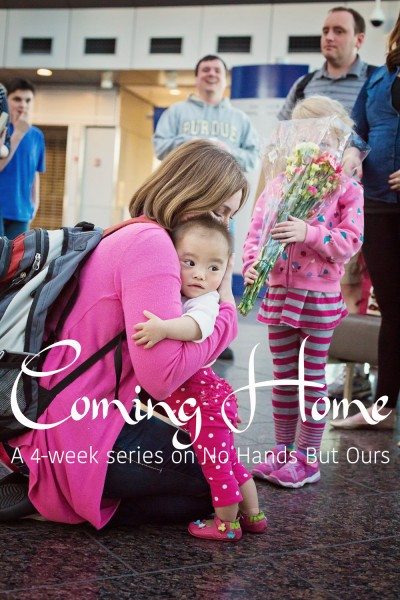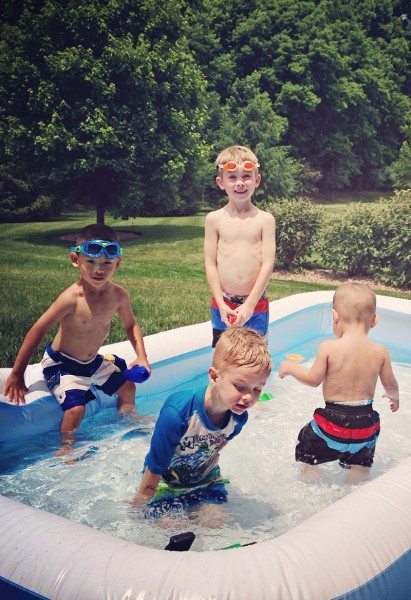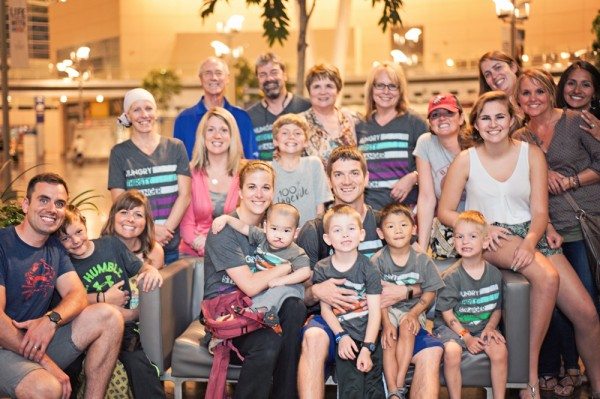You’ve made the exciting decision to adopt. Congratulations!
At this stage, you are either waiting to be matched with a child, or you are longing to hold your son or daughter each time you see your child’s precious pictures. The adoption journey is two-fold. First, you paper chase and wait to bring your child home. Then, you travel to China, and begin a new season of life as soon as your new love is placed in your arms. Both are exciting, emotional, difficult, and incredible times of life! During our first adoption, I kept viewing Gotcha Day as our finish line. Little did I know, that was only the beginning.
My husband and I have traveled to China twice to bring home our sons, once in 2013 and again this past May. I don’t remember when we learned about the idea of cocooning, but I do recall that it was very strongly recommended to us. Cocooning can be described as a very intensive care season, in which the parents meet all of their new child’s needs. Interactions with people outside of the immediate family and the environments to which the new child is exposed are both very limited. When a family cocoons, they keep their new son or daughter’s world very small, simple, and predictable.
Just like with biological children, as the parent, you get to make the rules. You can read books and posts and talk to other adoptive parents, but in the end, you get to decide what cocooning will look like for your family. Will your family heed the advice from experts who’ve made it their life’s work to know how to best transition a newly adopted child into your family? How many weeks or months will you cocoon? To which environments are you willing to expose your child after her/she comes home?
As you begin to consider how you’d like to structure your cocooning period, consider the following:
• Cocooning allows you to teach your child that you will meet his/her needs.
Families are designed in such a way that when a newborn baby has a need, his/her mother and father meets that need. This pattern of having a need and meeting a need occurs countless times throughout the day. Whether a diaper needs to be changed, the baby is hungry, or the child feels tired, the parents meet those basic needs over and over and over again. I remember the sleepless nights with my two biological sons all too well, as they cried to eat and then needed to be changed and rocked back to sleep. Although completely exhausting, I realize how truly purposeful that time was for my first two sons. I was constantly teaching them that I was their mother and that I would meet all of their needs, which built trust, security, and healthy attachment with my boys.
Children raised in an orphanage and/or foster care setting have likely had several caregivers. Both of our sons from China had a primary nanny with whom they formed attachments; however, several other nannies were present and also cared for them, especially when their primary ayis went home. Despite being loved by their nannies, both of our sons had needs that were not addressed during their time in China. For example, their behavior has led us to believe that they both knew hunger and that their injuries were not addressed as they would have been at home. The cocooning period allowed our children to experience nurturing from us and only us, teaching them that we will kiss their boo-boos when they fall down, make their meals, provide them with snacks and drinks, wash their hands and face after meals, play with them in safe ways, dress them in weather appropriate clothes, put them to bed at night, comfort them when they are scared, and hold them when they are sad. This period of time was an opportunity to shut out the outside world and build a foundation of unconditional love, nurture, and protection to increase their felt safety within our family.
• Cocooning helps your child learn that his/her family is different from outside people/groups.
Because your new child may have had many caregivers in China, he or she might demonstrate indiscriminate affection. This occurs when your child displays love and affection to anyone and everyone (e.g., hugging the woman standing behind you while you are in line at the grocery store). From an outsider’s perspective, this behavior may be considered cute and friendly; however, it is actually a survival mechanism, a coping technique that children learn in an institutional setting. They learn to gain attention and affection by behaving in a charming, friendly way. Sometimes it also earns the child extra food or rewards of some kind. When a family takes the time to cocoon, their child’s opportunities to display indiscriminate affection are very limited. The child can learn that his mom always gets his snack after naptime or that her dad always reads a story before bedtime. Children who have their needs consistently met by their parents do not need to find anyone else to help them. Their security grows deeper and deeper as the parents continuously provide for their every need. The cocooning period is a time to show your new child that they are part of your family and any future relationships are secondary to that family unit.
When my husband and I met one of our sons in China, we quickly realized that he would have walked away with anyone who came along his path. When other people were around, he would put on a performance, dancing, spinning, and charming anyone who came along. Going back to the orphanage was so interesting, as he was clearly very happy there. I believe with my whole heart that he wouldn’t have batted an eye had we walked out the door without him that day. Upon coming home, we knew that our son needed a longer, very secluded cocooning period in order to teach him the difference between family and outside people.
Even months after being home, we made sure to meet all of his needs rather than allowing someone else to help him. For example, if we went to a friend’s house for dinner, we made sure to serve his food, help him in the restroom, and comfort him if he got hurt. We told our friends and family to pay him very little attention (and sometimes even ignore his presence) and redirect him back to us if he approached them for help, to play, or to show them something. It was unnatural for our family and friends to behave that way, but they all respected our wishes and trusted our judgment. Once he had a better understanding of our family unit, and our attachment was more secure, we allowed a more natural interaction with friends and family.
We also had to provide our son with explicit instruction regarding affection. First, we taught that we kiss and hug our family but wave or high five our friends and extended family. Once his indiscriminate affection had dissipated, we began allowing hugs with our core friends and extended family. The benefits of that initial cocooning phase, as well as the following months where we kept outside interactions structured and controlled, were worth their weight in gold. Our son made so much progress and learned to differentiate between our family and other people.
• Cocooning limits your new child’s sensory experience.
When a baby is born, he or she begins to experience the world through seeing, hearing, touching, tasting, and smelling. When that child ends up living inside the walls of an institution, their sensory experience is typically very limited. Extended time in a crib often takes place, limiting that child’s interactions with others and with the world. An orphan’s diet can be quite simple in terms of flavor and texture with the same meals often being provided each day. Some children are allowed to go outside to play while others never leave their orphanage walls. Their brains are accustomed to their every day sensory experience, processing information as they use their five senses.
Then we walk into their lives, and everything changes. All of the sudden, we are meeting all of their needs, but oftentimes look, smell, and sound so completely different from their nannies. We are speaking to them in an unfamiliar language, and our gestures and other nonverbal tools for communicating might also be new. For meals we order an array of dishes with noodles and rice, steamed buns and congee but soon begin throwing in pizza, cheeseburgers, French fries, chicken sandwiches, tacos, and burritos. The textures and flavors are all so new and different. Sometimes they are easily chewed and swallowed, and other times, our new children spit them out.
Although many of our children have rarely – if ever – ridden in a vehicle, suddenly they are riding in taxis, vans, and buses (without car seats – mind you), and eventually they are flying across the world to their new home. The movement and motion they experience is unlike any experience they’ve had before. The level of noise at home, the numerous colors at the grocery store, and the various plant textures outside all have to be processed by a brain that is inexperienced with that level of sensation.
Cocooning addresses your child’s need for a controlled sensory environment. By keeping your child’s world very small, you will limit them to the sensory experience within your home first. Being around the family pet(s) is often very scary for newly adopted children. This adjustment period will help your child who has siblings who run and play and scream. Allowing your children to experience grass in your backyard can help them be prepared for a later trip to the park.
For one of my children adopted from China, we had to be very mindful of his level of sensory stimulation. If he became overwhelmed by sounds, sights, and movement around him, my son would cope by spinning in circles. To be honest, we went to the mall today, and he commented that the food court was very loud. He became super over-stimulated and struggled to focus, obey, and walk normally. This son has been home for almost two years, and his sensory issues are still present.
Oftentimes, if either of our sons newly home from China were over-stimulated by people or the environment, they would experince night terrors. When that happened, we had to reevaluate our schedule and maybe stay home the next day to rejuvenate instead of going to a splash pad as planned. The cocooning period helped our family stay flexible to meet our children’s needs as they adjusted to their new lives and all of the new sensory experiences they were having.
My experience with cocooning is limited to our two adoptions, but I am happy to share how we structured our cocooning period. For both our China babies, we came home and committed to 4-6 weeks with zero outside interactions. At the end of that period, we would reevaluate what the next stage would look like. For example, we could decide if more intense cocooning was necessary, or if we could begin some outside interactions.
We were so fortunate to have meals brought to our home 4 times a week during that cocooning period. Our friends and extended family would drop the meals off outside our garage, and we would go outside to pick them up. No one questioned us or felt that we were rude, as we had communicated how important it was for our new sons to not have outside interactions so newly home. For much of the time, we did stay home, playing inside or outside together as a family unit.
When I took our children to playgrounds, I tried to visit parks where very few people would be. For example, this summer, we often visited the playgrounds at schools versus the city parks that were much more crowded.
Although the cocooning period can feel very isolating, try to reframe this period of time in the most positive light you can. So many of us lives that are just too busy! Cocooning gives you an excuse to slow down and just enjoy your greatest treasure – your family. How many times in life do you put everything else on hold in order to invest 100% of your time in your family rather than outside relationships and commitments? It’s a rare and special opportunity, so take advantage!
To survive cocooning, I tried to keep a schedule and change our activities throughout the day. In the morning, my kids would eat breakfast and watch a couple cartoons. Then, they would get dressed, and we would often play at a school playground, rotating to a different one each time. After playing for an hour or two, we would come home to eat lunch. We would play in the playroom for an hour or so, and then they would take naps at 2:00 p.m. After naps we often went back outside to ride bikes and scooters, blow bubbles, and write with sidewalk chalk. Ryan would come home, and we would enjoy dinner as a family. The evening’s activity depended on how the day had gone and the weather.
To stay connected to friends and extended family, use FaceTime, texting, and regular phone calls. Although a person can waste a lot of time on social media, it can be a huge lifeline when you are so secluded from outside people. Consider getting together with friends after you put your kids to bed.
Try to remember that the sacrifices you make in those early days and weeks and months (if necessary) will reap incredible rewards! Your child’s security, attachment, and felt safety can grow leaps and bounds during the cocooning period. It is a small price to pay for the progress your child can make during that time.
If you are getting ready to travel to China to bring your child home, here is the letter we sent to our closest friends and family to help explain our family’s needs and expectations. Lifeline Children Services, our adoption agency, provided some of what you will read, but we also tailored their sample letter to meet our needs.
Feel free to use this example as you create your own letter. I think having clear expectations and strong communication will increase a greater understanding with your friends and family. Best wishes as you bring your child home and adjust to life as a new family!
Letter to Friends and Family
Dear Family and Friends,
As we get ready to embark on such an exciting event in our lives, we are thinking about all of you and how much our lives are about to change. Ryan and I are so fortunate to have such incredible family and friends. We appreciate the support and excitement that you have all shown us as we have made a second journey to China. We are thrilled to bring Tyson home! Our previous experience with bringing Tucker home, as well as our education and training for this adoption, have prepared us in how to help Tyson become a well-adapted member of our family.
I know a number of people are planning to meet us at the airport when we arrive home. We will be so excited to see anyone who can attend our homecoming celebration! After traveling for 28 hours home, we will arrive at the Indianapolis Airport on June 4th at 9:13 p.m. We appreciate you allowing us to greet Liam and Tucker, who will remain home during our trip, before visiting with the rest of our family and friends. Please be mindful not to overwhelm Tyson. Just like when we came home with Tucker, please do not touch or show affection to Tyson. Limit direct eye contact and communication to him, as this will be quite overwhelming for Ty. Feel free to hug and talk with Ryan, Noah, and me after we arrive. Giving attention to Liam and Tucker will also be great! No gifts are necessary!! I am working on scheduling a photographer to take pictures of our arrival. We plan to wear our Least of These t-shirts, and if any of you would like to do the same, feel free but no pressure to do so!
There are some things about adoptive parenting that are the same as parenting a biological child. There are also quite a few areas that we have learned are different. I think I realize now more than ever before how important it is to follow our training. We know that Tyson will need a specific type of environment and parenting when he comes home in order to feel safe and secure and to learn how to live successfully in our family.
While we know that every child is different, we also understand that Tyson’s history will impact his behavior when he gets home. The amount of nurturing Tyson received, the presence of abuse or neglect, the amount and quality of food received, illnesses experienced, the quality of care, and Tyson’s unique temperament and personality will all contribute to his behavior. This can result in behavioral issues, as well as a sense of grief and loss from being separated from the only home and caregivers he has ever known. Adoption is a traumatic and scary event for any age child whether they are newborn or 10 years old. Many people think that because Tyson is so young, he won’t be impacted as much. We are erring on the side that he will grieve tremendously for all that he will lose. This will best prepare us to support his needs. He is being removed from all of his routines and familiar surroundings. Even babies grieve and experience sadness at an event like this. In order to help Tyson feel safe and learn that we are his parents, we are creating the type of environment that will help promote security during this stressful time.
When Tyson comes home, at the recommendation of experienced adoption professionals, we need to implement specific parenting approaches to help encourage a strong, attached, emotionally healthy family member. Ty needs to learn that we’re his parents. He needs to feel nurtured and safe. He will not be used to having parents to love and care for him around the clock.
Here are some things we will be doing for our child based on research and experience with other adopted children. We plan to live a quiet life with limited trips out and no visitors in for a little while. Social workers and psychologists tell us that when children are first adopted, they may be overwhelmed, scared, and nervous. By keeping our lives very limited and consistent at first, we’ll be helping Tyson feel safe.
We know you’ll all want to hug, kiss and help Tyson, but it is recommended that we be the only ones to do that for awhile to improve his chances of strongly attaching to us. Until we feel Tyson has attached and clearly knows we are his parents, we will need to be the ones meeting all of his needs/wants. As strange as it may seem, adopted children who act very outgoing and affectionate with strangers is not a healthy thing. It is called “indiscriminate affection” and can mean that they haven’t really attached to anyone.
We appreciate your understanding in reading this. We’ve giving you all this letter so that you will understand how dedicated and committed we are to helping Tyson adjust and adapt during this stressful time in his life. Thanks for all of your support!
Amy and Ryan





























Hi there,
I appreciate the thorough article and it did really touch me. We are in foster to adopt process and we are having hard time as we have failed in the ‘cocooning process’ . our child has been living with us now for 6 weeks and he seems to be quiet angry ( week 6). we haven’t cooconed enough . meaning we took him out to visit family and friends few times .. he expressed some affection but last week was quiet something. he seems upset. to add to the equation we still bring him to see his bioloogical mother once a week as per the canadian regulation ( we are from Montreal Canada). We are in a period where we are being evaluated and trying to gain his trust, any advise as we are in a panic mode ( my wife broke down today).
[…] known as cocooning and will be limiting our activities outside the home (to understand this better here is a helpful post). When a baby is first born, the new family often take a few weeks to settle in at home and get to […]
This is a fantastic article!! Thank you–explaining the cocooning process to family members who can’t wait to snuggle the new family member is challenging. This definitely helps!
I am about to be an adoptive grandmother. While I understand the importance of cocooning I am so sad not to be a part of our new twin granddaughters’ lives for a while. We’ve waited so long for them. Can you share how the grandparents coped with this time and any tips you have?